sensor Peugeot Expert VU 2012 Owner's Manual
[x] Cancel search | Manufacturer: PEUGEOT, Model Year: 2012, Model line: Expert VU, Model: Peugeot Expert VU 2012Pages: 268, PDF Size: 9.73 MB
Page 4 of 268
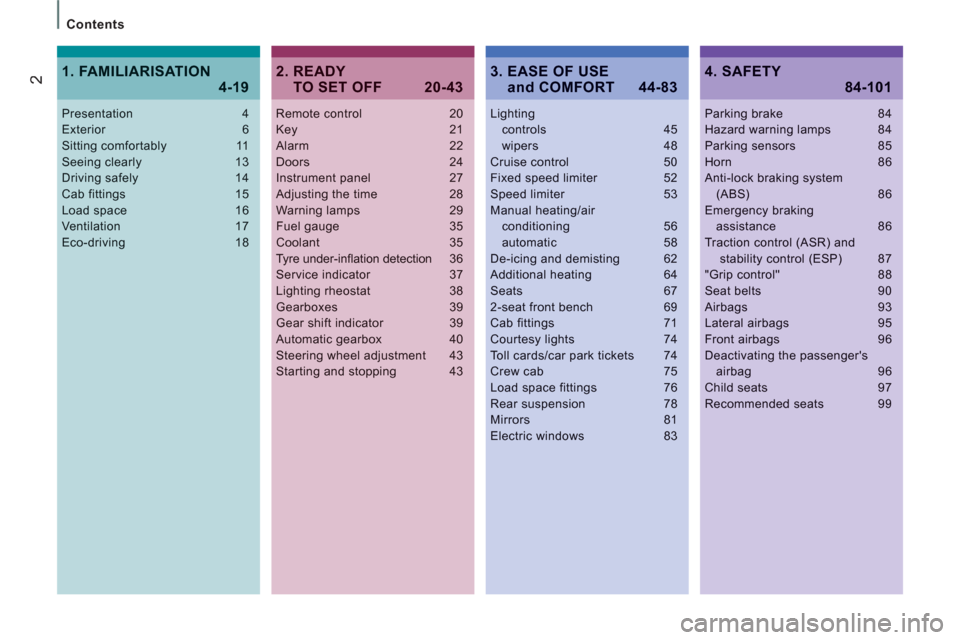
2
Contents
Remote control 20Key 21Alarm 22Doors 24Instrument panel 27Adjusting the time 28Warning lamps 29Fuel gauge 35Coolant 35Tyre under-infl ation detection36Service indicator 37Lighting rheostat 38Gearboxes 39Gear shift indicator 39Automatic gearbox 40Steering wheel adjustment 43Starting and stopping 43
Lightingcontrols 45wipers 48Cruise control 50Fixed speed limiter 52Speed limiter 53Manual heating/air conditioning 56automatic 58De-icing and demisting 62Additional heating 64Seats 672-seat front bench 69Cab fittings 71Courtesy lights 74Toll cards/car park tickets 74Crew cab 75Load space fittings 76Rear suspension 78Mirrors 81
Electric windows 83
2. READY
TO SET OFF 20-43
4. SAFETY
84-101
Presentation 4Exterior 6Sitting comfortably 11Seeing clearly 13Driving safely 14Cab fittings 15Load space 16Ventilation 17Eco-driving 18
1. FAMILIARISATION
4-19
Parking brake 84Hazard warning lamps 84Parking sensors 85Horn 86Anti-lock braking system(ABS) 86Emergency braking assistance 86Traction control (ASR) andstability control (ESP) 87"Grip control" 88Seat belts 90Airbags 93Lateral airbags 95Front airbags 96Deactivating the passenger'sairbag 96Child seats 97Recommended seats 99
3. EASE OF USE and COMFORT 44-83
Page 9 of 268
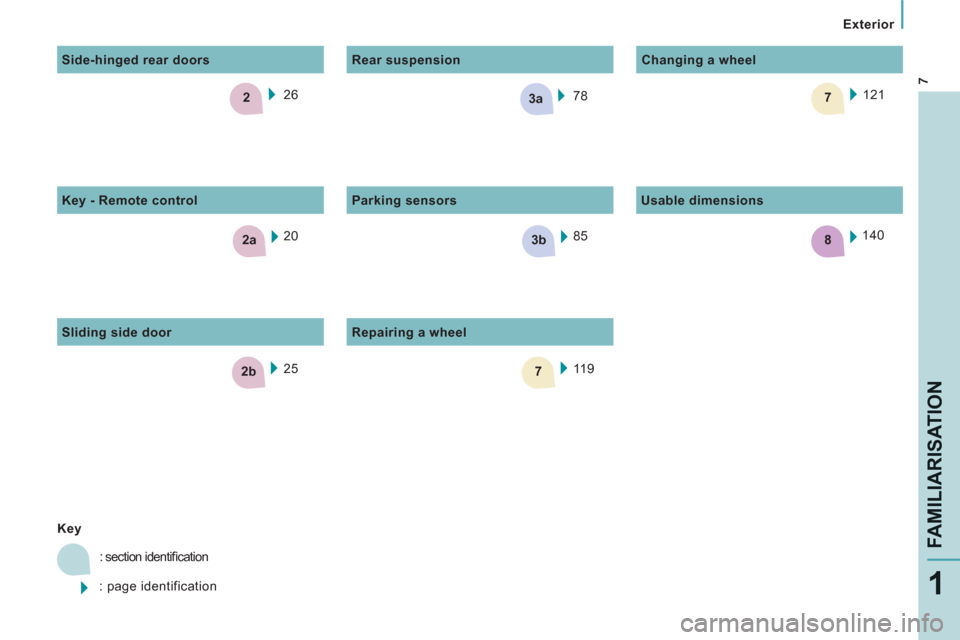
7
3b
7
8
3a
2b
2
2a
Exterior
FAMILIARISATIO
N
1
11 9 85
Rear suspension
Repairing a wheel
Parking sensors 121
Changing a wheel
78 26
25 20
Side-hinged rear doors
Key - Remote control
Sliding side door
Key
: section identifi cation
: page identification 140
Usable dimensions
Page 12 of 268
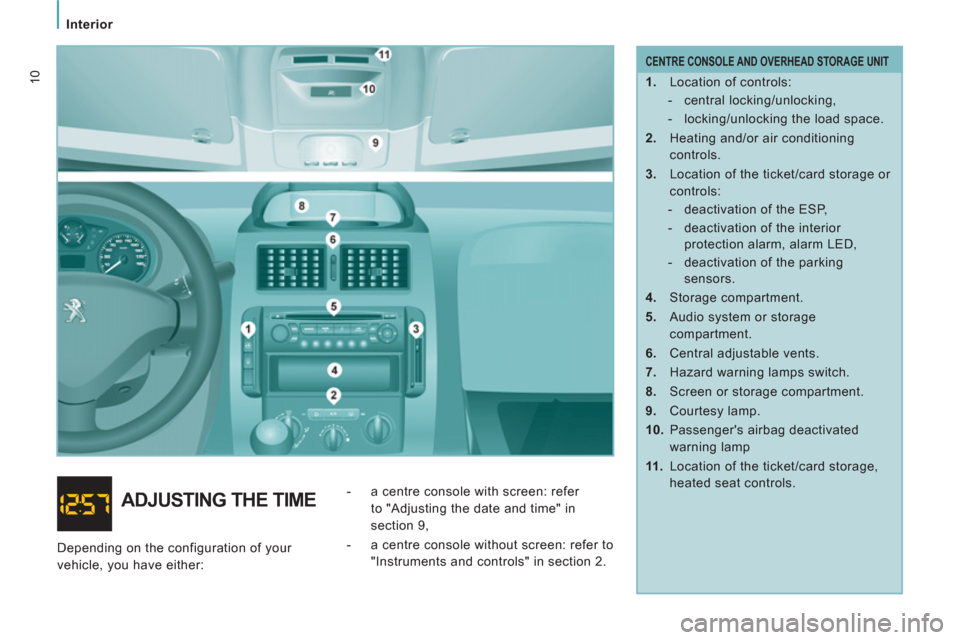
Interior
10
CENTRE CONSOLE AND OVERHEAD STORAGE UNIT
1.
Location of controls:
- central locking/unlocking,
- locking/unlocking the load space.
2.
Heating and/or air conditioning
controls.
3.
Location of the ticket/card storage or
controls:
- deactivation of the ESP,
- deactivation of the interior
protection alarm, alarm LED,
- deactivation of the parking
sensors.
4.
Storage compartment.
5.
Audio system or storage
compartment.
6.
Central adjustable vents.
7.
Hazard warning lamps switch.
8.
Screen or storage compartment.
9.
Courtesy lamp.
10.
Passenger's airbag deactivated
warning lamp
11 .
Location of the ticket/card storage,
heated seat controls.
ADJUSTING THE TIME
- a centre console with screen: refer
to "Adjusting the date and time" in
section 9,
- a centre console without screen: refer to
"Instruments and controls" in section 2.
Depending on the configuration of your
vehicle, you have either:
Page 38 of 268
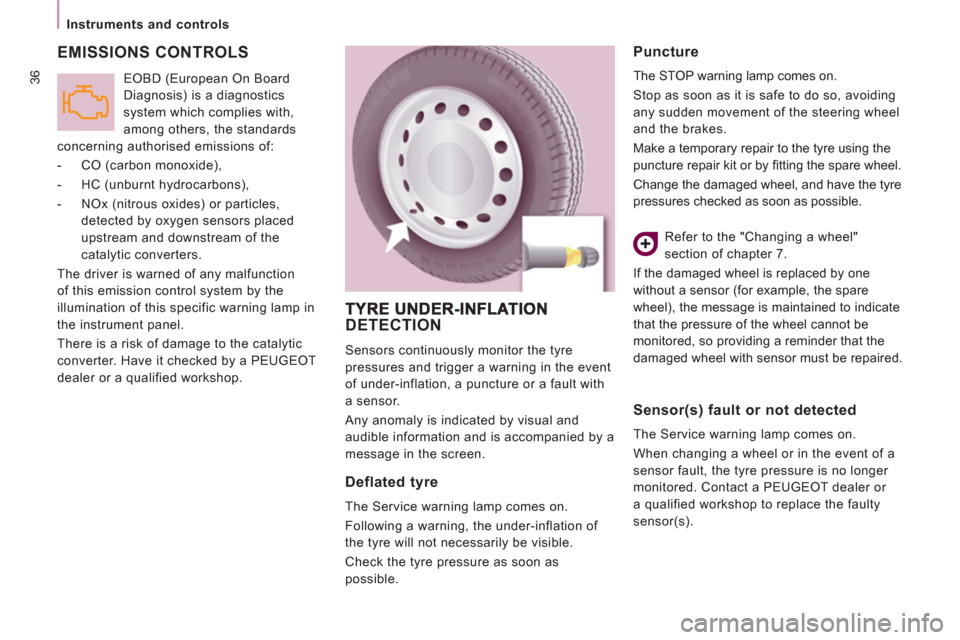
36
Instruments and controls
EMISSIONS CONTROLS
EOBD (European On Board
Diagnosis) is a diagnostics
system which complies with,
among others, the standards
concerning authorised emissions of:
- CO (carbon monoxide),
- HC (unburnt hydrocarbons),
- NOx (nitrous oxides) or particles,
detected by oxygen sensors placed
upstream and downstream of the
catalytic converters.
The driver is warned of any malfunction
of this emission control system by the
illumination of this specific warning lamp in
the instrument panel.
There is a risk of damage to the catalytic
converter. Have it checked by a PEUGEOT
dealer or a qualified workshop.
DETECTION
Sensors continuously monitor the tyre
pressures and trigger a warning in the event
of under-inflation, a puncture or a fault with
a sensor.
Any anomaly is indicated by visual and
audible information and is accompanied by a
message in the screen.
Deflated tyre
The Service warning lamp comes on.
Following a warning, the under-inflation of
the tyre will not necessarily be visible.
Check the tyre pressure as soon as
possible.
Puncture
The STOP warning lamp comes on.
Stop as soon as it is safe to do so, avoiding
any sudden movement of the steering wheel
and the brakes.
Make a temporary repair to the tyre using the
puncture repair kit or by fi tting the spare wheel.
Change the damaged wheel, and have the tyre
pressures checked as soon as possible.
Refer to the "Changing a wheel"
section of chapter 7.
If the damaged wheel is replaced by one
without a sensor (for example, the spare
wheel), the message is maintained to indicate
that the pressure of the wheel cannot be
monitored, so providing a reminder that the
damaged wheel with sensor must be repaired.
Sensor(s) fault or not detected
The Service warning lamp comes on.
When changing a wheel or in the event of a
sensor fault, the tyre pressure is no longer
monitored. Contact a PEUGEOT dealer or
a qualified workshop to replace the faulty
sensor(s).
Page 47 of 268
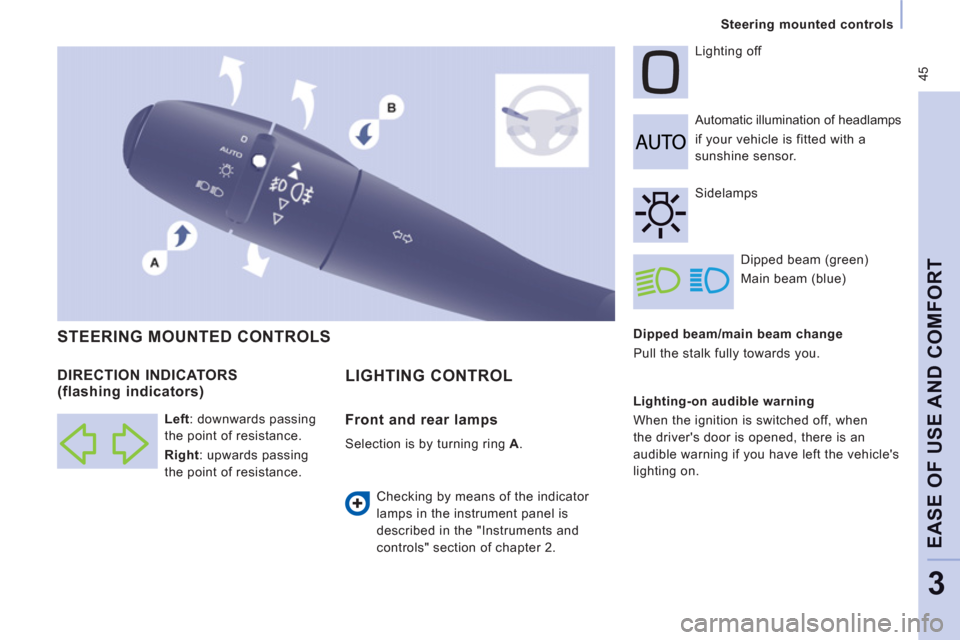
45
Steering mounted controls
EASE OF USE AND COMFOR
T
3
Dipped beam/main beam change
Pull the stalk full
y towards you.
Automatic illumination of headlamps
if
your vehicle is fitted with a
sunshine sensor. Li
ghting off
Dipped beam
(green)
Main beam (blue)
DIRECTION INDICATORS (flashing indicators)
STEERING MOUNTED CONTROLS
Checking by means of the indicator
lamps in the instrument panel is
described in the "Instruments and
controls" section of chapter 2.
Sidelamps
Lighting-on audible warning
When the ignition is switched o
ff, when
the driver's door is o
pened, there is an
audible warnin
g if you have left the vehicle's
lighting on.
Left: downwards passing
the point o
f resistance.
Right: upwards passing
the point o
f resistance.
LIGHTING CONTROL
Front and rear lamps
Selection is by turning ring A.
Page 49 of 268
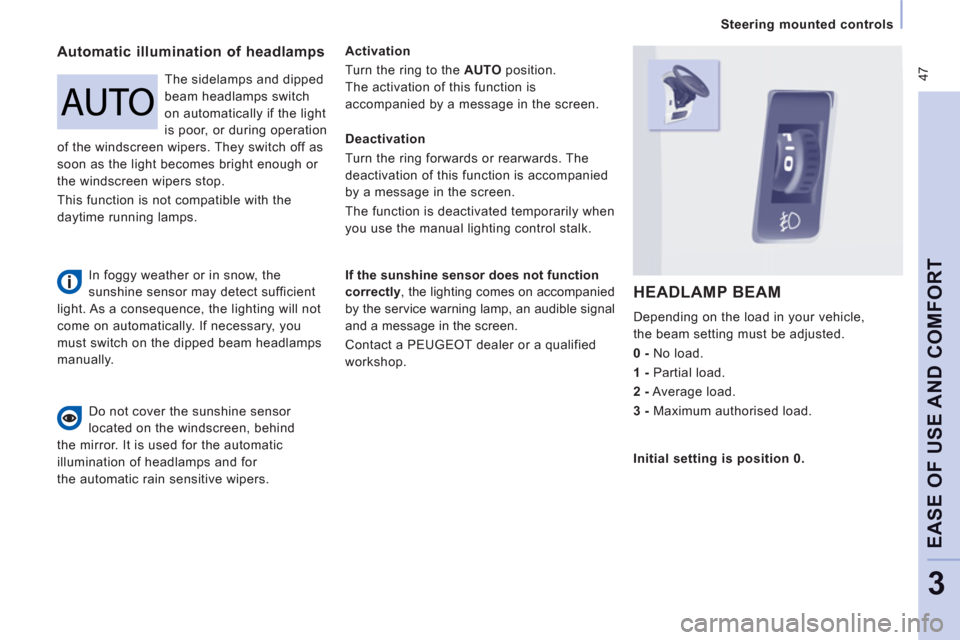
47
Steering mounted controls
EASE OF USE AND COMFOR
T
3
Automatic illumination of headlamps
Activation
Turn the ring to the
AUTOposition.
Th
e activation of this function is
accompanied by a message in the screen.
If the sunshine sensor does not function
correctly, the lighting comes on accompanied
by the service warning lamp, an audible signal
and a message in the screen.
Contact a PEUGEOT dealer or a qualified
workshop.
HEADLAMP BEAM
Depending on the load in your vehicle,
the beam settin
g must be adjusted.
0 -
N
o load.
1 -
Partial load.
2-
Average load.
3 -
Maximum authorised load.
Do not cover the sunshine sensor
located on the windscreen, behind
th
e mirror. It is used for the automatic
illumination of headlamps and for
the automatic rain sensitive wipers.The sidelam
ps and dipped
beam headlamps switch
on automaticall
y if the light
is poor, or durin
g operation
of the windscreen wipers. The
y switch off as
soon as the light becomes bright enough or
the windscreen wi
pers stop.
This
function is not compatible with the
da
ytime running lamps.
Deactivation
Turn the ring
forwards or rearwards. The
deactivation of this function is accom
panied
by a message in the screen.
The function is deactivated temporaril
y when
you use the manual lighting control stalk.
Initial settin
g is position 0.
In foggy weather or in snow, the
sunshine sensor may detect sufficient
light. As a consequence, the lighting will not
come on automatically. If necessary, you
must switch on the dipped beam headlamps
manually.
Page 61 of 268

59
Ventilation
EASE OF USE AND COMFOR
T
3
Driver or passenger side comfort value
The value indicated on the display
corresponds to a level of comfort and
not a temperature in de
grees Celsius or
F
ahrenheit.
Automatic operation
Do not cover the sunshine sensor,
l
ocated on the windscreen behind the
mirror, it is used for regulation of the air
conditioning.
AUTO comfort programme
This is the normal air conditioning system
operat
ing mode.
Press this button, the AUTOsymbol is
displayed.
Dependin
g on the comfort value selected,
t
he system controls the distribution,
the
fl ow and the intake of air to guarantee comfort
and a suffi cient circulation of air in the passen
ger
compartment. No further action on your part is required.
When the engine is cold, to prevent anexcessive diffusion of cold air, the ventilation
will reach its optimum level gradually.
For
your comfort, the settings are stored
when the ignition is switched off and arereinstated the next time the vehicle isstarted, if the temperature in the passenger compartment has not changed significantly;
otherwise, operation resumes in automatic
mode. T
urn this control to the left or to
the right to decrease or increase
the value. A settin
g around the
value 21 provides optimum
comfort. However, depending on your
requirements, a settin
g between 18 and 24
i
s usual.
Page 80 of 268

78
Rear suspension
Metal suspension
This equipment adopts long movement limiters
which make it possible to
guarantee stable
behaviour both when loaded and when empt
y.
No action on your part is required except to
ensure that maintenance is carried out and that
the authorised loads are com
plied with.irrespective o
f the weight of the load, within
the limit of the authorised values.
On board,
the increasin
g or lightening of the load on
the vehicle's plat
form is detected by two
hei
ght sensors. When all of the doors are
closed, the sensors trigger the automatic
hei
ght correction and determine the optimum
hei
ght of the sill for the vehicle's driving
conditions.
Deactivation of automatic height correction
The control which permits deactivation o
f
automatic re
gulation is located on the right-
hand side, at the rear of the vehicle.
REAR SUSPENSION
You must deactivate automatic height
correction manually in the following
situations:
- when working underneath the vehicle,
- when changing a wheel,
- when the vehicle is being transported by
lorry, train, ferry, boat, ...
Two t
ypes of suspension are available.
Rear suspension with pneumatic height correction
If fitted on your vehicle, this type of
suspension regulates the variations in the
height of the rear platform of your vehicle
1.
Automatic height
correction
2.
Manual height
correction
1 - Automatic correction of the
height of the rear sill
The pneumatic suspension automatically
re
gulates the variations in the height of the
rear plat
form of your vehicle.
A red warning light on your
instrument panel
fl ashes if the
height is not at its optimum level
and requires correction, drive slowl
y
until this warning lamp goes off.
The automatic hei
ght correction is
temporar
ily inactive:
- if a door/the tailgate is open,
- when braking or when stopped at a red
traffic signal (brake pedal pressed).
With the vehicle stationary:
- press and hold,
- release the control.
Return to automatic correction
With the vehicle stationary:
- press and hold,
- release the control.
According to the configurations, a beep may
be heard durin
g these operations.
Two functions Deactivation is con
firmed by the LED which
is on. It remains on for approximatel
y
30 seconds.
Return to automatic hei
ght correction is
confi rmed by the LED which goes off.
Page 87 of 268
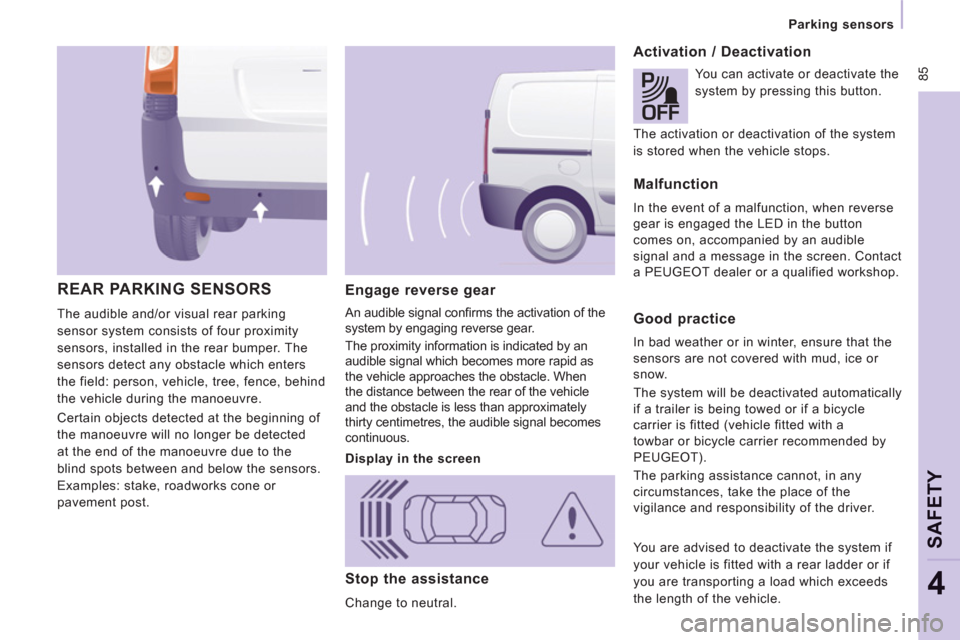
85
Parking sensors
SAFETY
4
Engage reverse gear
An audible signal confi rms the activation of the
system by engaging reverse gear.
The proximity information is indicated by an
audible signal which becomes more rapid as
the vehicle approaches the obstacle. When
the distance between the rear of the vehicle
and the obstacle is less than approximately
thirty centimetres, the audible signal becomes
continuous.
Stop the assistance
Change to neutral.
REAR PARKING SENSORS
The audible and/or visual rear parking
sensor system consists of four proximity
sensors, installed in the rear bumper. The
sensors detect any obstacle which enters
the field: person, vehicle, tree, fence, behind
the vehicle during the manoeuvre.
Certain objects detected at the beginning of
the manoeuvre will no longer be detected
at the end of the manoeuvre due to the
blind spots between and below the sensors.
Examples: stake, roadworks cone or
pavement post.
Activation / Deactivation
You can activate or deactivate the
system by pressing this button.
Malfunction
In the event of a malfunction, when reverse
gear is engaged the LED in the button
comes on, accompanied by an audible
signal and a message in the screen. Contact
a PEUGEOT dealer or a qualified workshop.
Good practice
In bad weather or in winter, ensure that the
sensors are not covered with mud, ice or
snow.
The system will be deactivated automatically
if a trailer is being towed or if a bicycle
carrier is fitted (vehicle fitted with a
towbar or bicycle carrier recommended by
PEUGEOT).
The parking assistance cannot, in any
circumstances, take the place of the
vigilance and responsibility of the driver.
Display in the screen
You are advised to deactivate the system if
your vehicle is fitted with a rear ladder or if
you are transporting a load which exceeds
the length of the vehicle.
The activation or deactivation of the system
is stored when the vehicle stops.
Page 105 of 268
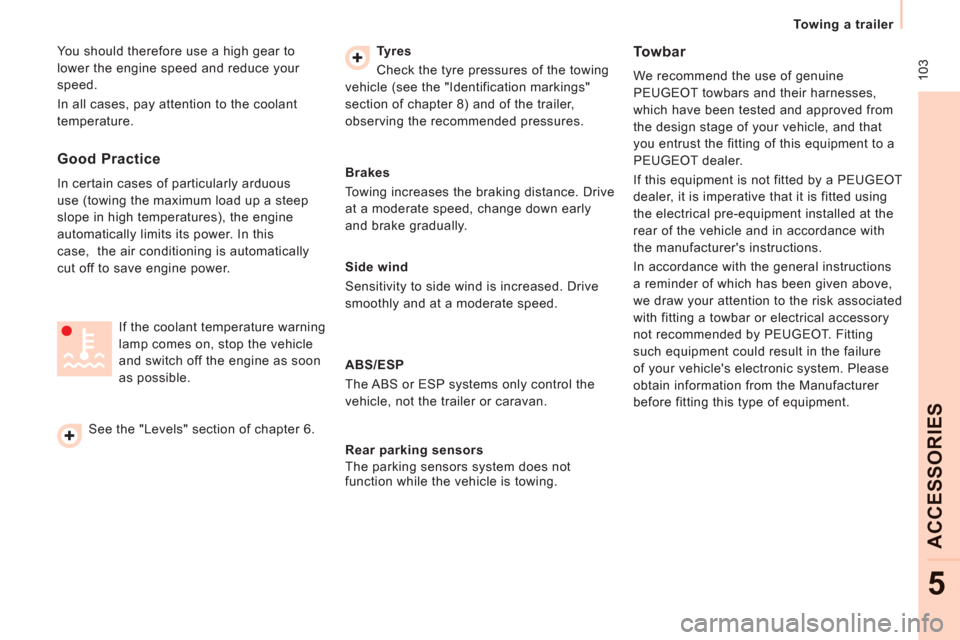
10
3
Towing a trailer
ACCESSORIE
S
5
You should therefore use a high gear to
lower the engine speed and reduce your
speed.
In all cases, pay attention to the coolant
temperature.
Tyres
Check the tyre pressures of the towing
vehicle (see the "Identification markings"
section of chapter 8) and of the trailer,
observing the recommended pressures.
Towbar
We recommend the use of genuine
PEUGEOT towbars and their harnesses,
which have been tested and approved from
the design stage of your vehicle, and that
you entrust the fitting of this equipment to a
PEUGEOT dealer.
If this equipment is not fitted by a PEUGEOT
dealer, it is imperative that it is fitted using
the electrical pre-equipment installed at the
rear of the vehicle and in accordance with
the manufacturer's instructions.
In accordance with the general instructions
a reminder of which has been given above,
we draw your attention to the risk associated
with fitting a towbar or electrical accessory
not recommended by PEUGEOT. Fitting
such equipment could result in the failure
of your vehicle's electronic system. Please
obtain information from the Manufacturer
before fitting this type of equipment.
See the "Levels" section of chapter 6.
Good Practice
In certain cases of particularly arduous
use (towing the maximum load up a steep
slope in high temperatures), the engine
automatically limits its power. In this
case, the air conditioning is automatically
cut off to save engine power.
If the coolant temperature warning
lamp comes on, stop the vehicle
and switch off the engine as soon
as possible.
Brakes
Towing increases the braking distance. Drive
at a moderate speed, change down early
and brake gradually.
Side wind
Sensitivity to side wind is increased. Drive
smoothly and at a moderate speed.
ABS/ESP
The ABS or ESP systems only control the
vehicle, not the trailer or caravan.
Rear parking sensors
The parking sensors system does not
function while the vehicle is towing.